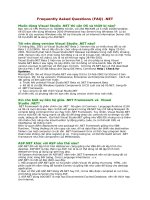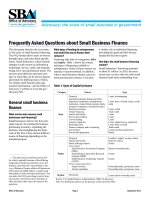Answers to 100 frequently asked questions about social security retirement benefits
Bạn đang xem bản rút gọn của tài liệu. Xem và tải ngay bản đầy đủ của tài liệu tại đây (1.57 MB, 97 trang )
100 Answers to Frequently Asked Questions about Social Security
Retirement Benefits
Edited by John Weber
Contents
Foreword
Introduction
Chapter One: Background
Chapter Two: Basics
Chapter Three: Eligibility
Chapter Four: When to Apply
Chapter Five: Applying
Chapter Six: Spouses, Dependents, and Survivors
Chapter Seven: Once You Are Retired
Chapter Eight: Recent Changes
Chapter Nine: The Future of Social Security
Afterword: Some Takeaways
Sources and Further Reading
About the Author
Foreword
On the back cover we state: “For most people, Social Security is their largest financial asset, worth
hundreds of thousands of dollars and indexed against increases in the cost of living.”
We also say: “This book may be worth tens—or even hundreds—of thousands of dollars to you!”
Here’s how:
The average monthly benefit in 2019 is $1,461. In order to generate that amount of income, you would
have to have $876,600 in the bank earning a 2% annual return.
The average life expectancy of a 65-year-old is now 20 years. At the average of $1,461 a month, that
comes to $350,640 in lifetime benefits. (And this does not include the increase from the cost-of-living
adjustments.)
The two main ways you can lose Social Security retirement benefits are failure to apply for benefits
that you are eligible for, and not maximizing your benefits.
Folks are almost always aware of the benefits due to them based on their own work record. Where
the money is usually lost is on the auxiliary benefits, especially spousal (married people, divorced,
and survivors). If this book makes you aware of your eligibility for benefits on someone else’s work
record, that could be very valuable information indeed!
About 40 percent of all retirees take their benefits at age 62, their first opportunity. They may not
know that their monthly benefit will be 76 percent larger if they can hold off until they are 70. Waiting
those eight years can generate an extra $1,000 a month for the rest of your life. If you live into your
late eighties, or nineties (or your spouse does), waiting to collect can be one of the best “investments”
you will ever make.
Introduction
“Life can only be understood backwards; but it must be lived forwards.”
S
— ØREN
KIERKEGAARD
The most important decision you will make about Social Security is when to start taking retirement
benefits. You can start as early as age 62 or delay until you are 70. The longer you wait, the larger
your monthly payment—but you won’t get as many payments.
So if you knew how long you were going to live, and there were no other considerations—such as a
spouse—you could pretty easily do the math and figure out how to collect the most money during your
retirement.
Unfortunately, we don’t know how long we’re going to live, so our most important decision about
Social Security is based on a guess. (5.7% of the people who pay into Social Security die before
collecting any benefits at all.) Factor in a spouse, and various strategies become possible, and the
calculation becomes much more complicated. Factor in the determination of certain politicians to
“reform” Social Security (by which they usually mean privatize it, or cut benefits*), and the
calculation becomes daunting.
All of the answers you will find here are available on the Social Security Administration website
(www.socialsecurity.gov); by phone (800-772-1213, Monday through Friday, 7 a.m. to 7 p.m.); or in
a visit to your local SSA office, the location of which can be found on the website or by calling.
But if you’ve ever visited the SSA website, you’ve probably found the amount of information
available overwhelming, disorganized, and mostly irrelevant to retirement issues (since the SSA is
also responsible for Disability and Unemployment Insurance, Medicare, and Medicaid, among other
Federal programs). If you’ve called their 800 number, you’re probably still on hold.
The answers to your specific questions may not be here, but if you’re reading this book, you are
probably about to make several of the most important financial decisions of your life, and this book
functions both as a primer and to dispel many of the common misconceptions people have about what
Social Security is and how it works.
It is the editor’s hope that, armed with the basic information contained here, you are better equipped
to talk to the SSA and/or your financial advisor when the time comes, and pose the questions that are
relevant to your own unique situation.
(Although, please note: While Social Security Administration employees are required to provide accurate information about the program,
they are PROHIBITED from offering advice as to how or when you should claim benefits.)
(Disclaimer: This book is not published, authorized, or endorsed by the Social Security Administration.)
Although all the “answers” in this book are taken verbatim from the SSA website and publications, some of the “questions” have been
“asked” by the editor. For instance, “What is the best age to start receiving retirement benefits?” does not appear among the SSA’s
FAQs. But, for example, SSA Publication No. 05-10147 begins with: “At Social Security, we’re often asked, ‘What is the best age to
start receiving retirement benefits?’”
The contents of this book do not constitute legal or accounting advice. Everyone’s situation is unique and you should consult with the
SSA and/or certified professionals before making important financial decisions.
*Under the guise of “closing loopholes,” the Bipartisan Budget Act of 2015 decreased the benefits paid to retirees by an estimated $9
billion a year under the heading “Protecting Social Security.” See Chapter 8, “Recent Changes.” (A hypothetical question for the
Congress of the United States: What shall we do to protect Social Security? Answer: Change the rules, cut benefits, and pay recipients
less. We’ll call it “Protecting Social Security.” Works every time.)
Chapter One
Background
1. What are the purposes of Social Security?
2. What programs are included under Social Security?
3. How large is Social Security?
4. How do Social Security benefits and Supplemental Security Income (SSI) payments differ?
5. How is Social Security financed?
6. What are FICA and SECA taxes?
7. What is the current maximum amount of Taxable Earnings for Social Security this year? How has
the Maximum Taxable Earnings changed over the years?
8. Do I “own” the money I pay in Social Security taxes?
9. What is the Old-Age and Survivors Insurance (OASI) Trust Fund?
1. What are the purposes of Social Security?
The Social Security Act and related laws establish a number of programs that have the following
basic purposes:
■ To provide for the material needs of individuals and families;
■ To protect aged and disabled persons against the expenses of illness that may
otherwise use up their savings;
■ To keep families together; and
■ To give children the chance to grow up healthy and secure.
2. What programs are included under Social Security?
The following programs are included:
■ Retirement insurance;
■ Survivors insurance;
■ Disability insurance;
■ Hospital and medical insurance for the aged, the disabled, and those with end-stage
renal disease;
■ Prescription Drug Benefit;
■ Extra help with Medicare Prescription Drug Costs;
■ Supplemental security income;
■ Special Veterans Benefits;
■ Unemployment insurance; and
■ Public assistance and welfare services, including:
• Temporary assistance for needy families;
• Medical assistance;
• Maternal and child health assistance;
• Child support enforcement;
• Family and child welfare services;
• Food stamps; and
• Energy assistance.
[EDITOR’S NOTE: This book deals ONLY with the first two programs listed above: RETIREMENT
and SURVIVORS INSURANCE.]
3. How large is Social Security?
In 2017, over 62 million Americans will receive approximately $955 billion in Social Security
benefits.
Per December 2016 Beneficiary Data
■ Retired workers: 41.2 million/ $56 billion/ $1,360 average monthly benefit [see
question #15 for current amount]
Their dependents: 3 million/ $2 billion
■ Disabled workers: 8.8 million/ $10.3 billion/
$1,171 average monthly benefit
Their dependents: 1.8 million/ $0.65 billion
■ Survivors: 6.1 million/ $6.8 billion
Social Security is the major source of income for most of the elderly.
■ Nearly nine of ten individuals age 65 and older receive Social Security benefits.
■ Social Security benefits represent about 34% of the income of the elderly.
■ Among elderly Social Security beneficiaries, 48% of married couples and 71% of
unmarried persons receive 50% or more of their income from Social Security.
■ Among elderly Social Security beneficiaries, 21% of married couples and about 43% of
unmarried persons rely on Social Security for 90% or more of their income.
Social Security provides more than just retirement benefits.
■ Retired workers and their dependents account for 71% of total benefits paid.
■ Survivors of deceased workers account for 13% of the total benefits paid.
• About one in eight of today’s 20-year-olds will die before reaching 67.
• About 96% of persons aged 20–49 who worked in covered employment in 2016 have survivors
insurance protection for their young children and the surviving spouse caring for the children.
An estimated 171 million workers are covered under
Social Security.
■ 51% of the workforce has no private pension coverage.
■ 31% of workers report that they and/or their spouse have no savings set aside specifically for
retirement.
In 1940, the life expectancy of a 65-year-old was almost 14 years; today it is about 20 years.
By 2035, the number of Americans 65 and older will increase from 48 million today to over 79
million.
There are currently 2.8 workers for each Social Security beneficiary. By 2035, there will be 2.2
covered workers for each beneficiary.
4. How do Social Security benefits and Supplemental Security Income (SSI) payments differ?
The two programs are financed differently.
■ Employment taxes primarily finance Social Security retirement, survivors, and disability insurance
benefits.
■ Generally, we pay Social Security benefits to eligible workers and their families, based on the
worker’s earnings.
■ Meanwhile, general taxes fund the SSI program, which serves the needy. SSI eligibility depends
largely on limited income and resources.
5. How is Social Security financed?
Social Security is financed through a dedicated payroll tax. Employers and employees
each pay 7.65 percent of wages up to the taxable maximum of $132,900 in 2019, while
the self-employed pay 15.3 percent.
6. What are FICA and SECA taxes?
The law requires employers to withhold taxes from employee earnings to fund the Social
Security and Medicare programs. These are called Federal Insurance Contributions Act
(FICA) taxes. Your employer also pays a tax equal to the amount withheld from employee
earnings.
The self-employed pay Self-Employed Contributions Act (SECA) taxes on net earnings. SECA taxes
also fund Social Security and Medicare. The self-employed pay both the employee and the employer
share of SECA. But the law permits them to deduct half of the self-employment tax as a business
expense.
7. What is the current maximum amount of taxable earnings for Social Security this year? How has the
Maximum Taxable Earnings changed over the years?
In 2018, the highest amount of earnings on which you must pay Social Security tax is
$128,700. In 2019 it is $132,900. We raise this amount yearly to keep pace with
increases in average wages. (There is no maximum earnings amount for Medicare tax.
You must pay Medicare tax on all of your earnings.)
Maximum Taxable Earnings Each Year
1937 – 50 $ 3,000 1982 $32,400 1998 $ 68,400 2014 $117,000
1951
1955
1959
1966
1968
1972
1973
1974
1975
1976
1977
1978
1979
1980
1981
–
–
–
–
–
54
58
65
67
71
3,600
4,200
4,800
6,600
7,800
9,000
10,800
13,200
14,100
15,300
16,500
17,700
22,900
25,900
29,700
1983
1984
1985
1986
1987
1988
1989
1990
1991
1992
1993
1994
1995
1996
1997
35,700
37,800
39,600
42,000
43,800
45,000
48,000
51,300
53,400
55,500
57,600
60,600
61,200
62,700
65,400
1999
2000
2001
2002
2003
2004
2005
2006
2007
2008
2009
2010
2011
2012
2013
72,600 2015 118,500
76,200 2016 118,500
80,400 2017 127,200
84,900
87,000
87,900
90,000
94,200
97,500
102,000
106,800
106,800
106,800
110,100
113,700
8. Do I “own” the money I pay in Social Security taxes?
We do not put the Social Security taxes you pay in a special account for you. They are
used to pay benefits for people getting benefits today, just as your future benefits will be
paid for by future workers.
9. What is the Old-Age and
Survivors Insurance (OASI) Trust Fund?
The Social Security trust funds are financial accounts in the U.S. Treasury. There are two
separate Social Security trust funds: the Old-Age and Survivors Insurance (OASI) Trust
Fund pays retirement and survivors benefits; and the Disability Insurance (DI) Trust Fund
pays disability benefits.
Social Security taxes and other income are deposited in these accounts, and Social Security benefits
are paid from them. The only purposes for which these trust funds can be used are to pay benefits and
program administrative costs.
The Social Security trust funds not needed in the current year to pay benefits and administrative costs
are, by law, invested in special Treasury bonds that are guaranteed by the U.S. Government. A market
rate of interest is paid to the trust funds on the bonds they hold, and when those bonds reach maturity
or are needed to pay benefits, the Treasury redeems them.
[SEE ALSO question #97: “What is the current status of the Old-Age and Survivors (OASI) Trust
Fund?”]
Chapter Two
Basics
10. What is a “mySocialSecurity” online account? What can I do with mySocialSecurity online
account?
Setting up a mySocialSecurity online account:
11. What is the verification process you use to set up a mySocialSecurity online account?
12. Will the Identity Services Provider charge me to set up or use a mySocialSecurity online account?
13. Can I create a mySocialSecurity account if I have a security freeze or fraud alert on my credit
report?
14. Why is Social Security asking for financial information online if I choose to add extra security to
mySocialSecurity account?
[EDITOR’S NOTE: In an article about protection against identity theft in The New York Times
(dated October 30, 2017), its author recommends opening a mySocialSecurity account to “stop
thieves from creating an account in your name, and redirecting benefits.”]
Benefit Basics:
15. What is the average monthly benefit for a retired worker?
16. What is the maximum Social Security retirement benefit payable?
10. What is a “mySocialSecurity” online account? What can I do with mySocialSecurity online
account?
“mySocialSecurity” is a free online account that gives you quick and secure access to your personal
Social Security information.
[EDITOR’S NOTE: If you value your time, setting up an account is a vastly superior alternative to
going down to the local Social Security office or calling their 800 number (800-772-1213 or TTY
800-325-0778). You can set up an account by going to www.ssa.gov/myaccount.]
If you do NOT receive benefits you can:
■ Get your Social Security Statement;
■ Estimate your benefits;
■ View your earnings record; and
■ Apply for retirement and spouse’s benefits.
If you receive benefits you can:
■ Get your benefit verification letter;
■ Check your payment information;
■ Change your address or phone number; and
■ Start or change direct deposit.
11. What is the verification process you use to set up a mySocialSecurity online account?
You must give us your identifying information and answer security questions to pass verification.
First, we match the personal information you give us with the data we have in our records. Then, we
use our “Identity Services Provider” to further verify your identity.
12. Will the Identity Services Provider charge me to set up or use a mySocialSecurity online account?
No, the “Identity Services Provider” will not charge you to set up a mySocialSecurity online account.
About the Identity Services Provider: The U.S. Social Security Administration uses an external data
source, or what we refer to as an “Identity Services Provider,” to help us verify the identity of our
online customers and to prevent fraudulent access to our customers’ sensitive personal information.
Equifax is the Identity Services Provider that provides identity verification services to the Social
Security Administration.
13. Can I create a mySocialSecurity account if I have a security freeze or a fraud alert on my credit
report?
You cannot create a mySocialSecurity account online if you have a security freeze, fraud alert, or both
on your credit report. You first must ask to have the freeze or alert removed.
To create a mySocialSecurity account in person without removing the security freeze or fraud alert,
visit your local Social Security office.
14. Why is Social Security asking for financial
information online if I choose to add
extra security to mySocialSecurity account?
Social Security’s new security process and federal guidelines require us to take extra measures to
verify your identity online. It helps us ensure you are who you say you are and it protects your
information.
15. What is the average monthly benefit
for a retired worker?
The average monthly Social Security retirement benefit for 2019 is $1,461.
16. What is the maximum Social Security
retirement benefit payable?
The maximum benefit depends on the age you retire. For example, if you retire at full retirement age
in 2018, your maximum benefit would be $2,788. However, if you retire at age 62 in 2018, your
maximum benefit would be $2,159. If you retire at age 70 in 2018, your maximum benefit would be
$3,698. The maximum benefit payable to a worker retiring at Full Retirement Age in 2019 is $2,861.
Chapter Three
Eligibility
Please see Chapter 6, “Spouses, Dependents, and Survivors,” for information concerning eligibility
for benefits based on someone else’s work record.
17. How do I earn Social Security credits and how many do I need to qualify for benefits?
18. Can work outside the United States help me qualify for Social Security benefits?
19. Can I contribute money to Social Security to earn extra credits?
20. How can I get a Social Security Statement that shows a record of my earnings and an estimate of
my future benefits?
21. How do I correct my earnings record?
22. Can I get Social Security retirement benefits and military retirement benefits?
23. If I get Social Security disability benefits and I reach full retirement age, will I then receive
retirement benefits?
24. Can non-citizens living in the United States receive Social Security benefits?
25. Can non-citizens living outside the United States receive Social Security benefits?
26. Can prisoners get Social Security payments?
27. What if I apply but Social Security decides I do not qualify for benefits? Will I receive a penalty
or fine?
17. How do I earn Social Security credits and
how many do I need to qualify for benefits?
We use your total yearly earnings to figure your Social Security credits. The amount needed for a
credit in 2019 is $1,360. You can earn a maximum of four credits for any year. The amount needed to
earn one credit increases automatically each year when average wages increase.
You must earn a certain number of credits to qualify for Social Security benefits. The
number of credits you need depends on your age when you apply and the type of benefit
application. No one needs more than 40 credits for any Social Security benefit.
18. Can work outside the United States help me
qualify for Social Security benefits?
The United States has Social Security agreements with more than two dozen foreign countries. The
agreements have two main purposes:
■ To eliminate dual Social Security payments and coverage; and
■ To help fill gaps in protection for workers who have divided their careers between the United
States and other countries.
19. Can I contribute money to Social Security
to earn extra credits?
You cannot get more credits by voluntarily contributing money to Social Security. You can earn
credits only by working in a job or your own business that is covered under Social Security.
20. How can I get a Social Security Statement
that shows a record of my earnings and
an estimate of my future benefits?
You can get your personal Social Security Statement online by using your mySocialSecurity account.
If you don’t yet have an account, you can easily create one. Your online Statement gives you secure
and convenient access to your earnings records. It also shows estimates for retirement, disability, and
survivors benefits you and your family may be eligible for.
We also mail paper Statements to workers age 60 and older three months before their birthday if they
don’t receive Social Security benefits and don’t yet have a mySocialSecurity account. Workers who
don’t want to wait for their scheduled mailing can request their Social Security Statement by mail—
please print and complete a “Request For Social Security Statement” (Form SSA-7004) and mail it to
the address provided on the form.
You should receive your paper Social Security Statement in the mail in four to six weeks.
21. How do I correct my earnings record?
Ordinarily, you cannot correct your earnings after three years, three months, and 15 days from the end
of the taxable year in which your wages were paid. However, you can correct your record after that
length of time to:
■ Confirm records with tax returns filed with the Internal Revenue Service;
■ Correct errors due to employee omissions from processed employer reports or missing reports;
■ Correct errors “on the face of the record,” that is, errors we can find by examining our records of
processed reports; and
■ Include wages reported by an employer as paid to an individual, but not shown in our records.
To correct your Social Security earnings record, contact us at 1-800-772-1213 (TTY 1-800-3250778). It will be helpful to have information such as Forms W-2, pay stubs, etc.
22. Can I get Social Security retirement benefits and military retirement benefits?
You can get both Social Security retirement benefits and military retirement. Generally, we do not
reduce your Social Security benefits because of your military benefits.
23. If I get Social Security disability benefits and I reach full retirement age, will I then receive
retirement benefits?
Social Security disability benefits automatically change to retirement benefits when disability
beneficiaries become full retirement age. The law does not allow a person to receive both retirement
and disability benefits on one earnings record at the same time.
24. Can non-citizens living in the United States
receive Social Security benefits?
Yes, if they are lawfully in the United States and meet all eligibility requirements. Lawfully present
non-citizens include, but are not limited to:
■ Non-citizens lawfully admitted for permanent residence under the Immigration and Nationality Act
(INA);
■ Certain non-citizens admitted under other INA classifications that allow them to live and work in
the United States;
■ Non-citizens admitted under Family Unity or Immediate Relative provisions; and
■ Other non-citizens who are fully insured for retirement, survivors, or disability benefits, and who
continue to meet U.S. lawful presence requirements.
Non-citizens authorized to work in the United States who got a Social Security number after
December 2003 can qualify for Social Security benefits.
25. Can non-citizens living outside the United States receive Social Security benefits?
In most cases, we stop payments to non-citizens after they are outside the United States for six
calendar months in a row. If we stop your payments, we will not start them again until you return to
the United States and remain for a full calendar month.
We may continue to pay benefits to non-citizens outside of the United States if they meet certain
conditions. Use our Payments Abroad Screening Tool to find out if you can continue to get benefits
while outside the United States.
For more information, see the SSA publication Your Payments While You Are Outside the United
States.
26. Can prisoners get Social Security payments?
Social Security prohibits payments to most prisoners.
We will suspend your Social Security benefits if you are confined to a jail, prison, or other penal
institution for more than 30 continuous days due to a criminal conviction. Although you can’t get
monthly Social Security benefits while you are confined, we will continue to pay benefits to your
dependent spouse or children as long as they remain eligible.
27. What if I apply but Social Security decides I do not qualify for benefits? Will I receive a penalty
or fine?
No, you will not receive a penalty or fine if Social Security denies your claim because you do not
qualify for benefits. Likewise, if you appeal that decision or apply again, you will not receive a
penalty or a fine.
Chapter Four
When to Apply
[EDITOR’S NOTE: Social Security provides several very helpful “Calculators” to help you decide
when to start taking your retirement benefits on their website: />benefitcalculators.html.]
28. What is the Social Security Retirement Age Calculator?
29. What is the Social Security Life Expectancy Calculator?
30. How does the Social Security Retirement Estimator work?
[EDITOR’S NOTE: Other Calculators compare the effect on your benefit amount if you retire early or
delay collecting; the effect of early retirement on the benefit for your spouse; and various other
special circumstances such as the effects of the Windfall Elimination Provision (which deals with
pensions based on work that was not covered by Social Security) and the Government Pension
Offset.]
FAQs:
31. When can I get Social Security retirement benefits?
32. What is full retirement age and when is it increasing?
33. What are Delayed Retirement Credits and how do they increase my monthly payments?
34. Can I retire anytime, or only on my birthdays?
35. What’s the best age to start receiving retirement benefits?
36. How do you figure out how much I will get?
28. What is the Social Security Retirement Age Calculator?
The Full Retirement Age is increasing.
Full retirement age (also called “normal retirement age”) had been 65 for many years. However,
beginning with people born in 1938 or later, that age gradually increases until it reaches 67 for
people born after 1959.
The 1983 Social Security Amendments included a provision for raising the full retirement age
beginning with people born in 1938 or later. The Congress cited improvements in the health of older
people and increases in average life expectancy as primary reasons for increasing the normal
retirement age.
NOTE: If you were born on January 1st of any year you should refer to the previous year.
[EDITOR’S NOTE: Available on the Social Security website, this calculator is simple to use: Just
fill in when you were born and it tells you what your Full Retirement Age is. You can retire as early
as age 62, or as late as age 70 regardless of what your Full Retirement Age is. The earlier you retire,
the less your monthly payment; the later you retire, the larger your monthly payment—but you won’t
get as many.]
Link to Retirement Age Calculator
/>29. What is the Social Security Life Expectancy Calculator?
When you are considering when to collect retirement benefits, one important factor to take into
account is how long you might live. According to data compiled by the Social Security
Administration:
■ A man reaching age 65 today can expect to live, on average, until age 84.3.
■ A woman turning age 65 today can expect to live, on average, until age 86.6.
And those are just averages. About one out of every four 65-year-olds today will live past age 90,
and one out of 10 will live past age 95.
Want to know your life expectancy? You can use our simple Life Expectancy Calculator to get a rough
estimate of how long you (or your spouse) may live. Knowing this information can help you make a
more informed choice regarding when to collect Social Security retirement benefits.
Link to Life Expectancy Calculator
/>30. How does the Social Security
Retirement Estimator work?
How the Retirement Estimator works
The Retirement Estimator gives estimates based on your actual Social Security earnings record.
Please keep in mind that these are just estimates. We can’t provide your actual benefit amount until
you apply for benefits. And that amount may differ from the estimates provided because:
■ Your earnings may increase or decrease in the future.
■ After you start receiving benefits, they will be adjusted for cost-of-living increases.
■ Your estimated benefits are based on current law. The law governing benefit amounts may change
because, by 2034, the payroll taxes collected will be enough to pay only about 79 cents for each
dollar of scheduled benefits.
■ Your benefit amount may be affected by military service, railroad employment, or
pensions earned through work on which you did not pay Social Security tax.
Who can use the Retirement Estimator
You can use the Retirement Estimator if…
■ You have enough Social Security credits at this time to qualify for benefits; and
■ You are not:
• currently receiving benefits on your own Social Security record;
• waiting for a decision about your application for benefits or Medicare;
• age 62 or older and receiving benefits on another Social Security record; or
• eligible for a pension based on work not covered by Social Security (for more go to
/>gpo-wep.html).
If you are currently receiving only Medicare benefits, you can still get an estimate. For more
information go to this link for our publication
Retirement Information for Medicare Beneficiaries.
If you cannot use the Retirement Estimator or you want a survivors or disability benefit estimate,
please use one of our other benefit Calculators.
Link to Social Security Retirement Estimator
/>
31. When can I get Social Security retirement benefits?
You can begin getting Social Security retirement benefits as early as age 62. But we will reduce your
benefits by as much as 30 percent below what you would get if you waited to retire until your full
retirement age. If you wait until your full retirement age (66 for most people), you will get your full
benefit. You also can wait until age 70 to start your benefits. Then, we will increase your benefit
because you earned “delayed retirement credits.”
32. What is Full Retirement Age and when is it increasing?
Age to Receive Full Social Security Benefits
(Called “full retirement age” or “normal retirement age.”)
Year of Birth *
Full Retirement Age
1937 or earlier
65
1938
65 and 2 months
1939
65 and 4 months
1940
65 and 6 months
1941
65 and 8 months
1942
65 and 10 months
1943–1954
66
1955
66 and 2 months
1956
66 and 4 months
1957
66 and 6 months
1958
66 and 8 months
1959
66 and 10 months
1960 and later
67
*If you were born on January 1st of any year you should refer to the previous year. If you were born
on the 1st of the month, we figure your benefit (and your full retirement age) as if your birthday was
in the previous month.
33. What are delayed Retirement Credits and how do they increase my monthly payments?
Social Security retirement benefits are increased by a certain percentage (depending on date of birth)
if you delay your retirement beyond full retirement age.
The benefit increase no longer applies when you reach age 70, even if you continue to delay taking
benefits.
Increase for Delayed Retirement
Year of Birth*
Yearly Rate of Increase
1933 – 1934
5.5%
1935 – 1936
6.0%
Monthly Rate of Increase
11⁄24 of 1%
1⁄2 of 1%
1937 – 1938
13⁄24
6.5%
of 1%
1937 – 1938
6.5%
13⁄24 of 1%
1939 – 1940
7.0%
7⁄12 of 1%
1941 – 1942
7.5%
5⁄8 of 1%
1943 or later
8.0%
2⁄3 of 1%
* If you were born on January 1st, you should refer to the rate of increase for the previous year.
34. Can I retire anytime, or only on my birthdays?
[EDITOR’S NOTE: You can retire anytime and apply anytime. Here is how your benefits will be
affected month-by-month if you were born between 1943–1954.]
How Early Retirement Affects Your Social Security Benefits
Early Retirement Age Benefit Early Retirement Age Benefit
62
75.0% 64 + 6 months
90.0
62 + 1 month
75.4
64 + 7 months
90.6
62 + 2 months
75.8
64 + 8 months
91.1
62 + 3 months
76.3
64 + 9 months
91.7
62 + 4 months
76.7
64 + 10 months
92.2
62 + 5 months
77.1
64 + 11 months
92.8
62 + 6 months
77.5
65
93.3
62 + 7 months
77.9
65 + 1 month
93.9
62 + 8 months
78.3
65 + 2 months
94.4
62 + 9 months
78.8
65 + 3 months
95.0
62 + 10 months
79.2
65 + 4 months
95.6
62 + 11 months
79.6
65 + 5 months
96.1
63
80.0
65 + 6 months
96.7
63 + 1 month
80.6
65 + 7 months
97.2
63 + 2 months
81.1
65 + 8 months
97.8
63 + 3 months
81.7
65 + 9 months
98.3
63 + 4 months
82.2
65 + 10 months
98.9
63 + 5 months
82.8
65 + 11 months
99.4
63 + 6 months
83.3
66
100.0
63 + 7 months
83.9
63 + 8 months
84.4
63 + 9 months
85.0
63 + 10 months
85.6
63 + 11 months
86.1
64
86.7
64 + 1 month
87.2
64 + 2 months
87.8
64 + 3 months
88.3
64 + 4 months
88.9
64 + 4 months
88.9
64 + 5 months
89.4
How Delayed Retirement Affects Your Social Security Benefits
Delayed Retirement Age Benefit Delayed Retirement Age Benefit
66
100% 69
124.0%
66 + 1 month
100.7% 69 + 1 month
124.7%
66 + 2 months
101.3% 69 + 2 months
125.3%
66 + 3 months
102.0% 69 + 3 months
126.0%
66 + 4 months
102.7% 69 + 4 months
126.7%
66 + 5 months
103.3% 69 + 5 months
127.3%
66 + 6 months
104.0% 69 + 6 months
128.0%
66 + 7 months
104.7% 69 + 7 months
128.7%
66 + 8 months
105.3% 69 + 8 months
129.3%
66 + 9 months
106.0% 69 + 9 months
130.0%
66 + 10 months
106.7% 69 + 10 months
130.7%
66 + 11 months
107.3% 69 + 11 months
131.3%
67
108.0% 70 or later
132.0%
67 + 1 month
108.7%
67 + 2 months
109.3%
67 + 3 months
110.0%
67 + 4 months
110.7%
67 + 5 months
111.3%
67 + 6 months
112.0%
67 + 7 months
112.7%
67 + 8 months
113.3%
67 + 9 months
114.0%
67 + 10 months
114.7%
67 + 11 months
115.3%
68
116.0%
68 + 1 month
116.7%
68 + 2 months
117.3%
68 + 3 months
118.0%
68 + 4 months
118.7%
68 + 5 months
119.3%
68 + 6 months
120.0%
68 + 7 months
120.7%
68 + 8 months
121.3%
68 + 9 months
122.0%
68 + 10 months
122.7%
68 + 11 months
123.3%









